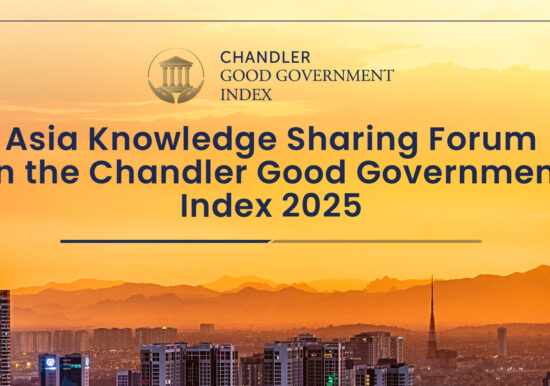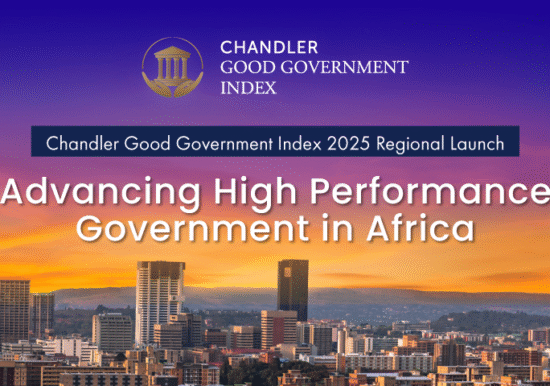
2024 Chandler Good Government Index Insights
Good government now, and for the challenges of tomorrow
The 2021 to 2023 editions of the CGGI Report traced the arc of the COVID-19 pandemic and examined the governance capabilities countries needed to survive and thrive during and after the crisis. In 2024, however, the prevailing challenges countries confront seem only to have been compounded.
Good governance has become a more complex and precarious field than ever. At the same time, new opportunities and prospective ways of governing are emerging. We see the CGGI and this Report as contributing to a culture of learning, adaptation, and change—helping countries to understand where they stand as they navigate today’s uncertain world and prepare for tomorrow’s challenges.
This year, we examine how good governance relates to the challenges and opportunities countries are expected to face in coming years. What might a country’s overall CGGI score tell us about its ability to govern for the future? The breadth of government capabilities that the CGGI measures, and its geographical reach–113 countries, or more than 90% of the world population–allows us to shed light on these questions with some depth.
To do this, we consider the key domains that are of prime concern to governments, and which hold the potential for existential challenges, both now and in the future. Leaving aside the persistent threat of pandemics that have been covered in previous Reports, we focus our 2024 analysis on the following domains:




Good Governments Are More Poised Towards Peace
r=0.95


Geopolitical stability is fundamental to a nation’s security and the wellbeing of its citizens. It provides the necessary conditions for sustainable development, economic prosperity, effective governance, and positive engagement in the global community. In turn, these contribute to greater societal wellbeing and an environment in which people may rise.
In 2024, however, conflict is raging in Europe, the Middle East and elsewhere, and tensions are rising in Asia. Observers have warned that geopolitical risks are higher than at any point in recent history. According to data from the Uppsala Conflict Data Program,1 there are now more active armed conflicts involving sovereign states, and displaced persons, than at any time since World War II. Is good governance associated with an orientation towards peace and stability, rather than conflict?
A strong relationship emerges when we compare countries’ CGGI overall scores with the Positive Peace Index, a political risk assessment tool developed by The Institute for Economics & Peace that analyses the necessary conditions for peace and for society to flourish.2 Good governments are shown to prioritise peace-building elements that allow their nations to fully function, thrive, and address the needs of citizens.

Socio-economic development requires long-term coordinated efforts that build on a range of key elements and capabilities, as reflected in the pillars of the CGGI. Every government wants to create a more prosperous and equitable society for its citizens. Beyond GDP, sustainable socio-economic development calls for governments working with businesses and investors to ensure a steady flow of resources, capital, and talent to their respective country. This is part of something we at the Chandler Institute of Governance term the “governance competition”. This competition will remain a challenge for any country well into the future. The competition for global talent illustrates this well. INSEAD’s Global Talent Competitiveness Index (GTCI) measures how countries are competing globally for the talent they need to fuel innovation, economic growth, and overall competitiveness. So, to compete effectively, prudent governments put in place policies to “grow their own talent pools, attract talent from underrepresented and underprivileged domestic sources, as well as overseas and external sources, and to develop the means to retain these essential workers.”3
Comparing the 2024 CGGI rankings with the 2023 GTCI rankings, another very strong relationship emerges. Good governments are good at managing talent: not just attracting the right people, but making the most of their contributions, and retaining their engagement and commitment over time. The GTCI 2023 Report also predicts that in the coming decade, the competition for talent will become fiercer still, and that, “talent competitiveness will gain even more importance as a critical element of competitiveness, innovation, and geopolitical soft power”.
Good Governments Grow, Attract, Retain, and Develop Talent
r=0.96

Good Governments Are Ready For AI
r=0.90


The year 2023 was a watershed for artificial intelligence (AI), with the world, including governments, coming to realise the transformative potential— as well as unprecedented risks—of emerging AI technologies. In this rapidly evolving space, slow-moving governments are especially vulnerable. Xiaolan Fu, Professor of Technology and International Development at the University of Oxford’s Department of International Development, has remarked that AI is a “milestone in human history”, but that the world’s poorest countries are ill-prepared.4 How ready then are governments around the world to meet the AI challenge?
This year’s countries’ CGGI rankings show a strong relationship with the Government AI Readiness Index5, an effort by Oxford Insights to assess the AI readiness of 193 governments worldwide. The Index comprises 39 indicators reflecting the intersection of government strategy, its technology sector, and its data and infrastructure setup.

The World Economic Forum’s 2024 Global Risks Report, released earlier this year, asked global leaders to rank the risks most likely to present a material crisis on a global scale over the next decade.6 Their responses indicate that by 2034, environmental risks would be the most concerning, accounting for the top four risks by severity:
- Extreme weather events
- Critical change to Earth systems
- Biodiversity loss and ecosystem collapse
- Natural resource shortages
Good Governments Can Adapt to Environmental Threats
r=0.94

Climate shocks and environmental threats have long been on governments’ radar as existential, and they remain the most complex and intractable concerns for our planet. Worryingly, many of the countries most at risk of these nature-based challenges are also among the least prepared to effectively govern and manage them. The Notre Dame-Global Adaptation Country Index (NDGAIN) 7, which aims to help governments, businesses, and communities better prioritise investments in light of future global challenges, includes analysis of a country’s vulnerability to climate change and other environmental challenges, along with its readiness to improve resilience. Here, vulnerability means a country’s exposure, sensitivity, and capacity to adapt to the negative effects of climate change by considering six life-supporting sectors–food, water, health, ecosystem service, human habitat, and infrastructure. Readiness measures a country’s ability to leverage investments and convert them to adaptation actions by considering three components –economic readiness, governance readiness, and social readiness.
There is a very strong correlation between a government’s performance in the CGGI and its preparedness to adapt to climate-related threats. This paints a concerning picture for the future of the world’s most climate-vulnerable countries. It reiterates the urgent need for countries to address the governance issues that hinder efforts to head off or mitigate these and other anticipated risks.
It is our sincere hope that the CGGI, in describing and measuring the diverse capabilities underpinning sound governance, we can contribute to helping countries ready themselves to better govern for tomorrow, and to overcome the challenges facing us ahead.
Endnotes
- Uppsala Conflict Data Program: Department of Peace and Conflict Research. (n.d.). Uppsala Conflict Data Program. https://ucdp.uu.se/
- Vision of Humanity. (2022, January 30). Positive Peace Report 2022: Analysing the factors that build, predict, and sustain peace. Vision of Humanity; Institute for Economics and Peace. https://www.visionofhumanity.org/positivepeace-report-2022-analysing-the-factors-that-buildpredict-and-sustain-peace/
We recognise that the CGGI and Positive Peace Index may share common underlying indicators. From an in-depth comparison, we identified five such indicators within the CGGI. Removing them from the CGGI drops the correlation between the two indices marginally from -0.947 to -0.935.
- Lanvin, B., & Monteiro, F. (2023). The Global Talent Competitiveness Index 2023: What a Difference Ten Years Make What to Expect for the Next Decade (p. 13). INSEAD. https://www.insead.edu/system/files/2023-11/gtci-2023-report.pdf
We recognise that the CGGI and Global Talent Competitiveness Index may share common underlying indicators. From an in-depth comparison, we identified five such indicators within the CGGI. Removing them from the CGGI drops the correlation between the two indices marginally from 0.960 to 0.949.
- Fu, X. (2023, November 3). Expert comment: Oxford AI experts comment on the outcomes of the UK AI Safety Summit. University of Oxford. https://www.ox.ac.uk/news/2023-11-03-expert-comment-oxford-ai-experts-comment-outcomes-uk-ai-safety-summit
- Government AI Readiness Index 2023. Oxford Insights. https://oxfordinsights.com/ai-readiness/ai-readiness-index/
We recognise that the CGGI and Government AI Readiness Index may share common underlying indicators. From an in-depth comparison, we identified three such indicators within the CGGI. Removing them from the CGGI drops the correlation between the two indices marginally from 0.900 to 0.897.
- The Global Risks Report 2024. (2024). World Economic Forum. https://www3.weforum.org/docs/WEF_The_Global_Risks_Report_2024.pdf
- ND-GAIN Country Index. (2023). Notre Dame Global Adaptation Initiative. https://gain.nd.edu/our-work/country-index/
We recognise that the CGGI and ND-GAIN Country Index may share common underlying indicators. From an in-depth comparison, we identified six such indicators within the CGGI. Removing them from the CGGI drops the correlation between the two indices marginally from 0.935 to 0.926.
More Stories


Watch the Chandler Good Government Index 2025 Regional Launch

